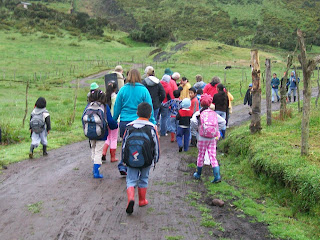 Another special person I met in Ecuador was Franklin! He was my Spanish tutor during my trip. Franklin would sit with me and purposely initiate conversations with me in Spanish in order to help me practice. He was very patient with me and I was able to have several meaningful conversations with him in Spanish. On my last day in Ecuador, I had a conversation with him about my parents. I told him my father lives in heaven with God (I didn't know how to say that he had died). I also told him that my mother struggles with some health issues and lives with my sister. I told him that my mother cannot always think clearly anymore and that it is difficult for us to see her aging. Franklin was very encouraging and reminded me that "La cuerpa is de la tierra." This entire conversation took place in Spanish and I found it very comforting.
Another special person I met in Ecuador was Franklin! He was my Spanish tutor during my trip. Franklin would sit with me and purposely initiate conversations with me in Spanish in order to help me practice. He was very patient with me and I was able to have several meaningful conversations with him in Spanish. On my last day in Ecuador, I had a conversation with him about my parents. I told him my father lives in heaven with God (I didn't know how to say that he had died). I also told him that my mother struggles with some health issues and lives with my sister. I told him that my mother cannot always think clearly anymore and that it is difficult for us to see her aging. Franklin was very encouraging and reminded me that "La cuerpa is de la tierra." This entire conversation took place in Spanish and I found it very comforting.Towards the end of my trip to Ecuador, Franklin told me that he did not know how to speak any Spanish until he was sent to Quito when he was twelve to go to school. Up until then, he had only spoken the Quechua language. I then had a little more insight into why Franklin had been so patient with me while I struggled to put sentences together in Spanish...poor pronunciation and incorrect verb tenses and all!
On our last night, Franklin took us to his church in Quito. He attends a Quechua church. I was able to video tape a portion of the women of the church singing to us...in Quechua. Enjoy!
What was truly special was feeling an incredible bond to these Quechua people because we are united in Christ Jesus!














































